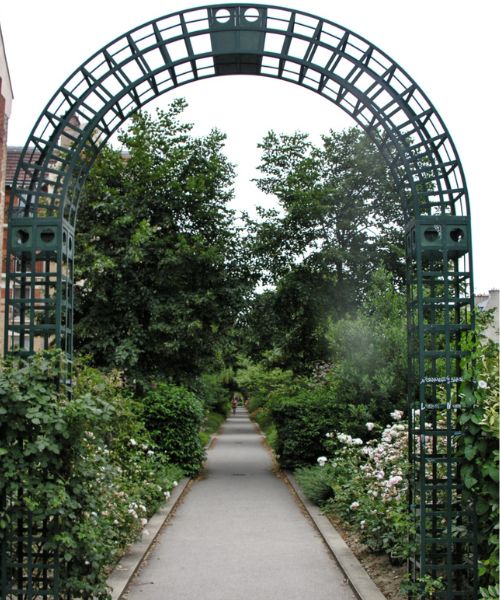We of course have great loyalty to our lovely local Heaton Moor Park.
Sometimes though, we look around in other nearby areas. Catherine Deering reports on two new parks in Manchester and the whole idea of ‘linear parks,’ an idea whose time has come?
You can wait for years for a new park, and then two come along at once. In nearby Manchester, two new gorgeous green spaces – one linear, one maybe kind of linear, have been created for from dereliction.
Mayfield Park – lining a river
Mayfield, park, the first Manchester city centre public park in over 100 years, opened its gates on Thursday 22nd September 2022.
Once a 6.5 acres mostly derelict, former industrial site next to Piccadilly Station has been transformed into Mayfield Park and likewise, the area.
Surrounding the banks of the often forgotten river Medlock, Mayfield park offers play areas, space for sports, floodable meadows and provides a quiet, inclusive green space for respite from city life.
The play area sports several slides for children, one wheelchair friendly.
During the Industrial Revolution, the site was used as a printing factory, later becoming a railway station and parcel depot. After the station closed, it became derelict for some time, before a public/private partnership has successfully refurbished the space for the benefit of local residents, office workers and visitors.
One feature of the park is the uncovering of the River Medlock, which had been concreted over into a culvert and just left to become dirty and turgid.
It is now clean and it is hoped that a lot of wildlife will return. In addition, Three historic wells were uncovered during the refurbishing, and it is hoped that this will keep the park green even in times of little rain. Mayfield Park, Manchester
Several buried rivers are in London and possibly in other UK cities. Meanwhile, across the Channel, The EU Water Framework Directive aims to resuscitate buried waterways across the continent by 2027: European Waterway Framework
Garden in the Sky – line of a viaduct
Back in Manchester, not far away from Mayfield Park, the National Trust has developed and is operating the old Castlefield viaduct as a linear park, a “garden in the sky.” It is approximately 50 feet off the ground and has 3,000 newly planted shrubs, bushes, ferns etc. This is a clever and creative adaptive re-use, attuned to the local environment.
This Grade II-listed, 19th-century railway bridge was built in 1892, then abandoned in 1969 when Manchester Central Station was closed. Presently, the Garden in the Sky can be visited by ticket only: Garden in the Sky, Manchester
Looking at linear parks further afield
Linear parks like this seem to be an idea whose time has come, although they have been around for for about 30 years.
In the UK
The Tide, London’s first elevated park, runs from Peninsula Square to the river and around the peninsula. Featuring art installations, independent food and drink outlets and meditation points, it currently is 1 km long, but there are plans to extend it to 5 km. The Tide, Greenwich Peninsula, London
In Europe

The Promenade Plantee in Paris is thought to be the first park of this type, created in 1988.
Often described as a hidden gem, off the beaten track but worth beating a track to, the Promenade Plantree rises ten metres above the street, a beautiful, three-mile path from the Bois de Vincennes to Bastille.
Image: The Promenade Plantee, Paris, Eric Parker)
The Hofbogen in Rotterdam was a mammoth task to develop. The run-down Hofplein Line viaduct and Bergweg Station, were completely renovated, creating pedestrian, retail, and community spaces under and around its arches as well as a green park above. Hofbogen Park, Rotterdam
The most well known high rise linear park is probably New York’s High Line on Manhattan island, built on an old elevated railway that fell out of use in the early 1980s.
It took over 20 years, but New Yorkers eventually repurposed this track to become a much-loved accessible green space in the south of the island by 2004. Its green space provides health and psychological benefits to the public, it increases biodiversity, gives a corridor to wildlife movement, and reduces the heat of the city: .
It may come as no surprise that a group – ‘Friends of High Line’ founded in 1999 was a driving force behind its creation and current operation! The High Line, New York
More recently, the ‘606’ in Chicago, featuring the Bloomingdale Trail, opened in 2015. A 2.7-mile multi-use trail and park constructed on the long-defunct Bloomingdale elevated rail line, it is also known for its innovative art works. The 606, Chicago
China
The Tanghe River Park in Qinhuangdao, also known as the “red ribbon,” integrates lighting and native plantings. It glows in the dark, ingeniously integrating nature and technology. For a detailed description from an architectural viewpoint, visit Tanghe River Park, Qinhuangdao
These new green infrastructure projects offer much to enjoy. However a potential downside “Eco-gentrification” as such developments have the potential to price local people out and encourage building high-priced properties.
Still, the creation of these parks, under-used and under-valued land integratWA nature into the local environment/industrial heritage, turning a declining landscape into a high quality and lovely amenity.

